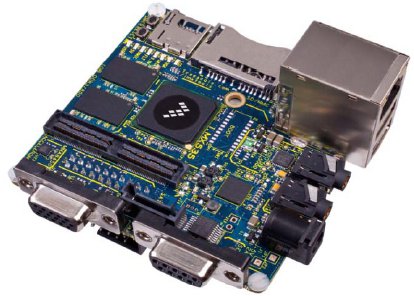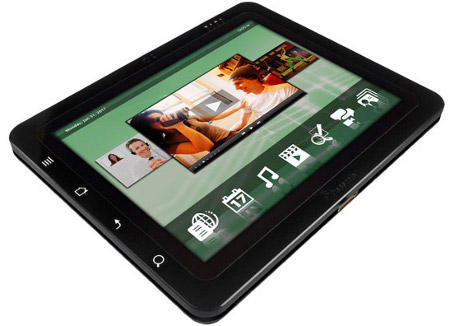Freescale spins Cortex-A8 SoCs, tablet design, and $149 dev board
Feb 28, 2011 — by Eric Brown — from the LinuxDevices Archive — 3 viewsFreescale Semiconductor announced two new members of its i.MX53 family of Cortex-A8 system-on-chips: an industrial-focused, 800MHz i.MX37 and the consumer-oriented, 1GHz i.MX538. Also unveiled were a $149 “Quick Start” development board for the original i.MX535 SoC, as well as a 10.1-inch, $1,499 “SABRE” tablet reference design, both compatible with Android, Linux, and Windows Embedded Compact 7.
Freescale announced its i.MX53 family of SoCs starting last May with the consumer-oriented i.MX535 (see later in this story for background). While the i.MX535 is shipping now, the newly announced i.MX538 appears to offer some incremental improvements over it.
It similarly offers a 1GHz ARM Cortex-A8 core, and supports 1080p video decode and 720p encode. Again, target applications are said to be tablets, smartphones, navigation devices, MIDs, IP phones, digital phone frames, connected TVs, and smart monitors.
The i.MX538 principally differs from the i.MX535 in that it is offered in a 12 x 12mm Package-on-Package (PoP) housing. The PoP technology allows vertical layering of logic and memory ball grid array packages, resulting in a smaller footprint, says the company. In addition, the i.MX538 adds support for LPDDR2 memory, as well as optional MMC/SD flash memories, says Freescale.
As with the i.MX535 and i.MX538, the processor supports Android, Linux, and Windows Embedded Compact 7.
i.MX537 aims at industrial market
Also newly announced is the 800MHz i.MX537, again Cortex A8-based. This SoC is designed for industrial and HMI applications, plus patient monitors, telehealth devices, point-of-sale (PoS) terminals, surveillance cameras, digital signage, and barcode scanners, says Freescale. Like the i.MX535 and i.MX538, the SoC supports 1080p decode and 720p encode, says the company.
Industrial-focused features are said to include 3.3V I/O support, as well as extended temperature coverage of -40 to 185 deg. F (-40 to 85 deg. C). One key addition on the i.MX537 is the addition of dual CAN 2.0 I/O modules that are said to support both standard and extended message frames, as well as a flexible number of message buffers. In addition, a new 10/100 Ethernet controller adds IEEE 1588 time stamping support, says Freescale.
Available in a 0.8mm pitch package to reduce PCB and manufacturing costs, the processor ships with "industrial qualification" and product longevity support, says the company.
New i.MX53 QuickStart board
Perhaps influenced by Texas Instruments' success with low-cost development boards such as the BeagleBoard, Freescale has taken a no-frills approach to its i.MX53 Quick Start board. A number of earlier i.MX SoCs have been supported with elaborate, expensive product development kits (PDKs) complete with peripheral add-ons, such as the i.MX31 PDK.

i.MX53 Quick Start board
The Quick Start board measures just 3.0 x 3.0 inches on an eight-layer PCB, matches a 1GHz i.MX535 CPU with a Dialog DA9053 PMIC chip and 1GB of DDR3 memory, says Freescale. Both a full-size SD/MMC and a microSD slot are provided, as is a SATA connector, says the company.
The i.MX53 Quick Start board is equipped with VGA and LVDS ports, a 10/100 Ethernet port, and three USB ports. An expansion connector is said to open up additional I/O ranging from HDMI to camera interfaces to I2C.
Included in the package are drivers, software-optimized multimedia codecs, and "other critical components," says Freescale. The Quick Start board ships with an optimized Linux distribution "that is supported by a large and vibrant community of open source developers at imxcommunity.org," says Freescale.
Adeneo will soon supply Android 2.2 and Windows Embedded Compact 7 board support packages (BSPs) for the board, with Android 2.3 support said to be coming soon.
Features and specifications listed for the i.MX53 Quick Start board include:
- Processor — Freescale i.MX535 @ 1GHz; Dialog DA9053 PMIC chip
- Memory — 1GB of DDR3 RAM
- Flash expansion — 1 x full-size SD/MMC slot; 1 x microSD slot
- Storage — 7-pin SATA connector
- Display:
- VGA connector
- LVDS connector
- parallel LCD or HDMI add-on card via expansion connector
- supports 4.3-inch, 24-bit 800 x 480 display with 4-wire touchscreen
- Networking — 10/100 Ethernet port
- Other I/O:
- 2 x high-speed USB ports
- 1 x micro-USB device port
- Mic and headphone jacks
- SPDIF audio via HDMI add-on card
- Expansion connector for LCD, HDMI, camera CSI, I2C. SSI, SPI
- JTAG connector
- DB-9 UART port
- Other features — 3-axis Freescale accelerometer; Freescale SGTL5000 audio codec
- Power — 5V, 2A
- OS and tools support:
- Linux BSP from Freescale
- Android 2.2 BSP from Adeneo
- Windows Compact 7 BSP from Adeneo
- Segger/CodeSourcery, Macgraigor, IAR debug, IDE toolchain
- Mentor Graphics Inflexion UI tool
- VMware player for Windows PC image
i.MX53 SABRE tablet reference platform
Freescale also announced a 10.1-inch tablet reference design, somewhat similar to the seven-inch Smartbook tablet design it offered for the i.MX515 back in Jan. 2010.
The Smartbook design was largely a third-party effort, whereas the new i.MX525-based SABRE (Smart Application Blueprint for Rapid Engineering) design is an in-house job and much more complete and closer to being production ready, says Freescale. It is unclear whether it is based on Intrinsyc's tablet software for the i.MX535 or was created independently (see farther below).

i.MX53 SABRE tablet reference design
(Click to enlarge)
The 10.1-inch capacitive multitouch display offers 1024 x 768 resolution, says Freescale. A five-megapixel camera is supplied, and HD video can be delivered to a TV via the HDMI port, says Freescale.
A full range of wireless features includes optional 3G, as well as a standard ZigBee radio for home automation and remote control duty, says the company. Other I/O is said to include Ethernet, USB ports, and audio I/O.

i.MX53 SABRE tablet
(Click to enlarge)
Features and specifications for the SABRE tablet platform are said to include:
- Processor — Freescale i.MX535 @ 1GHz
- Memory — 1GB of DDR3 RAM
- Storage:
- 8GB eMMC
- 32GB SanDisk SSD (optional)
- 1 x full-size SD/MMC slot
- 1 x SATA port
- Display — 10.1-inch, 1024 x 768 capacitive multitouch display
- Networking — 10/100 Ethernet port
- Wireless communications:
- Wi-Fi (Atheros AR6003)
- Bluetooth (Atheros AR3001)
- GPS (Atheros GM22)
- ZigBee (Freescale MC1323X)
- 3G (optional); Infineon Amazon-1 3G Module
- Camera — five-megapixel Omnivision OV5642
- Other I/O:
- 2 x high-speed USB ports
- 1 x micro-USB device port
- HDMI port
- Mic and headphone jacks
- JTAG connector
- DB-9 UART port
- Other features:
- Freescale 3-axis accelerometer
- Freescale SGTL5000 audio codec
- Freescale MAG3112 compass
- Stereo speakers
- Power, reset, volume buttons
- Operating system — BSPs for Linux, Ubuntu Linux, Android, Windows Embedded
Stated Ken Obuszewski, product marketing director for Freescale';s Multimedia Applications Division, "Ease-of-use is a hallmark of Freescale's i.MX products, and our latest i.MX53 development solutions and market-specific products underscore this distinction."
Background on the i.MX535
The i.MX535 was the first of an i.MX53 family of SoCs that was the heir to Freescale's i.MX51 family of ARM Cortex-A8 processors. It boosted video decode performance to multi-format 1080p HD and improved peripheral support, including new DDR3, SATA, and LVDS interfaces.
The i.MX535 offers 32KB each of L1 instruction and data cache, and 256KB of L2 cache, says Freescale. The SoC also offers 720p video encode, with integrated HD duplex video support said to support videoconferencing.
The i.MX535 was originally said to run at up to 1GHz, but when Intrinsyc announced a tablet-oriented software reference platform for the SoC in December, it said the processor had moved up to 1.2GHz. Now, Freescale says the i.MX535 can be cranked up to 1.3GHz, although the two development products are both set at 1GHz.
In October, Freescale announced two 800MHz automotive versions of the i.MX53 family. The i.MX534 includes dual graphics processors for 2D/3D video acceleration, while the i.MX536 adds an enhanced video processor.
Availability
The i.MX537 and i.MX538 processors are now available in sample quantities for select customers, with general sampling anticipated in June.
The i.MX53 Quick Start board is now available for a suggested resale price of $149, and the SABRE tablet platform is expected to be available for order in March at a suggested resale price of $1,499, says Freescale.
More information may be found at Freescale's i.MX53 page. More on Quick Start may be found at Freescale's i.MX53 Quick Start page. Freescale's iMX development site may be found at imxcommunity.org.
This article was originally published on LinuxDevices.com and has been donated to the open source community by QuinStreet Inc. Please visit LinuxToday.com for up-to-date news and articles about Linux and open source.